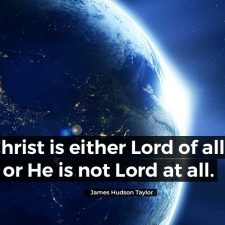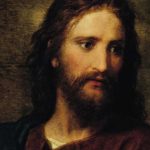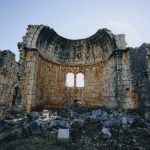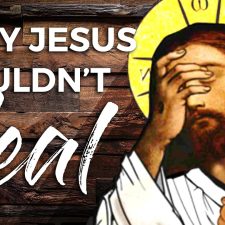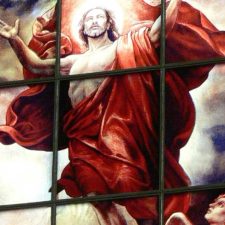35 Again the next day John [the Baptist] was standing with two of his disciples, 36 and he looked at Jesus as He walked, and said, “Behold, the Lamb of God!” 37 The two disciples heard him speak, and they followed Jesus. 38 And Jesus turned and saw them following, and said to them, “What do you seek?” They said to Him, “Rabbi (which translated means Teacher), where are You staying?” 39 He said to them, “Come, and you will see.” So they came and saw where He was staying; and they stayed with Him that day, for it was about the tenth hour. 40 One of the two who heard John speak and followed Him, was Andrew, Simon Peter’s brother. 41 He found first his own brother Simon and said to him, “We have found the Messiah” (which translated means Christ). (John 1:35-41)
In John 1:11, “Jesus came to His own [the Jews], but those who were His own did not receive Him.” Very few had any interest in following Jesus. Yet right from the very beginning of His public ministry, He was looking for disciples, those who would be willing to learn from Him by accepting His instruction as truth, as rules to live by. God is always working through His disciples; in the Old Testament they were referred to as the remnant, those that refuse to bow their knee to Baal (1 Kings 19:18). The continuation of the new covenant requires ones who will carry on the work after Jesus’s time on earth was completed and His followers would be an integral part of this new work of God.
The Apostle John reports in John 1:35-51 that the day after the baptism in the Jordan River, Jesus was looking to establish disciples, ones who would follow after Him and learn personally what it meant to be a true follower. John the Baptist identifies Him as the Lamb of God, a reference to his willingness to be sacrificed for others (Mark 10:45) and a symbol that followers of Christ would have to suffer. Paul captured the essence of this reality in Romans 8:36, quoting from Psalm 44:22, which says, “for your sake we are being put to death all day long; we were considered as sheep to be slaughtered”. If you are looking for glory, this is not it!
Come and see
As an ordained minister, I have grown up to understand that looking for glory, especially as a church leader, is a trap and has only led to discouragement. Christ intended that none would glory in anything except the cross of our Lord Jesus Christ (Galatians 6:14), the place where I am willing to die to me and my private interests in order to experience Him (Galatians 2:20). John the Baptist understood this and expressed it in John 1:26-27, “I baptize with water, but among you stands One whom you do not know. It is He who comes after me, the thong of whose sandal I am not worthy to untie”.
Throughout this passage, Jesus is saying to the newfound followers, “Come and you will see.” (verse 39) The key to becoming a follower of Christ is that you must come and see. Christianity is not a spectator sport, but it requires a willingness to act, taking steps of faith and in the process you will see unexpected things that will strengthen your faith. You will see Him do things in your life that will prove His faithfulness. The disciples’ three years with Jesus was a time to come and see. The same is true for us; we too must come and see.
A direct connection to Christ
In the passage, we also notice that two of the disciples belong to John the Baptist and they immediately became followers of Jesus. In John 3:29, John the Baptist acknowledged that he was not the bridegroom, but only a friend.
Unlike many religious systems, the new covenant is defined by a believer and his relationship to Christ and not to some other teacher or leader. Paul addressed this very issue in 1Corinthians 1:12-13, “Now I mean this, that each one of you is saying, ‘I am of Paul,’ and ‘I of Apollos,’ and ‘I of Cephas,’ and ‘I of Christ.’ 13 Has Christ been divided? Paul was not crucified for you, was he? Or were you baptized in the name of Paul”? This is a foundational principle of the new covenant, that each believer is directly related to Jesus and Jesus to each believer. In Hebrews 8:10, “I will be their God and they shall be my people”.
In Exodus 20:18-19, the Israelis were gathered at Mount Sinai with God who was demonstrating His presence on the mountain top with fire and lightning and thunder and earthquakes and the people were afraid. As a result, they told Moses to go up and hear from God and tell them what He said. This is a picture of many believers who are afraid to hear directly from God, but will listen to others. Because of the work of Christ on the cross, we do not have to be afraid of God.
After one is introduced to Christianity, he learns by following the example of others, including church leaders and may not be connected to Christ. As he grows, he gleans all that he can from a mentor, but there comes a time when he recognizes that he needs more and is no longer satisfied with the status quo. The disciples of John the Baptist were now ready to become deeply connected to Christ. John had been pointing them to Messiah all along.
Abiding fellowship
John 1:38 also tells us that Jesus’s first words to the new disciples were, “What do you seek?” Jesus was checking their motive for following. The Greek word for follow, “akoloutheo”, means more than coming behind, but it has a deeper sense of abiding fellowship with Him. If they are to become His disciples, they must come and see and stay with Him. They needed to get to see how He lived, how He responded to others, and how He dealt with many different situations. Our ability to follow Jesus is not just showing up at church on Sunday morning, but it involves the way we live our lives and Jesus has lessons for us through the Scriptures that can teach us how to face life’s challenges. A disciple learns how to follow Jesus closely.
We also see that a true disciple has a hard time keeping quiet about his relationship with Christ. Andrew, one of those disciples of John the Baptist that now follows Jesus, immediately goes to tell his brother Simon that, “We have found the Messiah” (John 1:41) and in the presence of Jesus is renamed Peter and he also becomes a follower. Then, Philip speaks to his friend, Nathanael and tells him the same basic message, that “we have found Him of whom Moses in the Law and Prophets wrote…” Once Jesus demonstrates His messiahship to Nathanael, he also follows. As one becomes a true follower, he will desire to share his faith with others.
Discipleship
In Luke 14:16-27, Jesus used a parable as an illustration of the more common excuses for not becoming a follower of Christ. The challenges that believers face relate to relationships with the details of life. When those details, including relationships with family members, job, pursuit of personal interests, etc. become more important than the pursuit of Jesus, then you cannot be a true follower (disciple). In verses 26-27, “If anyone comes to Me, and does not hate his own father and mother and wife and children and brothers and sisters, yes, and even his own life, he cannot be my disciple. Whoever does not carry his own cross and come after me cannot be My disciple.” The big dinner that Jesus speaks of is the “Marriage Supper of the Lamb” found in Revelations 19:9 where all believers in Christ will become His bride. Our biggest priority will be our new relationship with Him and He wants that to be our priority today as well. This is a process of growing in grace and the knowledge of our Lord (2 Peter 3:18).
A walk of faith
One major difference between the old and new covenants is that the Jews always needed a sign, some physical confirmation that they were hearing from God. In John 6:30, the Jews said to Jesus, “What then do You do for a sign, so that we may see, and believe You? What work do You perform”? Their faith was limited by what they saw. These same limitations existed throughout the Old Testament times. This is why God used the cloud by day and the pillar of fire by night to move the nation of Israel throughout the wilderness. They learned to trust the outward sign of the cloud and pillar of fire to know that they were moving with God. But the new covenant disciple is one who must learn to walk by faith and not by sight (2 Corinthians 5:7). He learns not to rely on his eyes, but develops his sixth sense of faith, knowing that he has heard God and moves forward. God is faithful to lead every believer by His Spirit and believers must learn how to listen to His still small voice (sound of a gentle whisper) in the midst of the busyness of life. One great example of this principle is illustrated in the healing of the man born blind in John 9:35-41.
35 Jesus heard that they had put him out, and finding him, He said, “Do you believe in the Son of Man?” 36 He answered, “Who is He, Lord, that I may believe in Him?” 37 Jesus said to him, “You have both seen Him, and He is the one who is talking with you.” 38 And he said, “Lord, I believe.” And he worshipped Him. 39 And Jesus said, “For judgement I came into this world, so that those who do not see may see, and that those who see may become blind.” 40 Those of the Pharisees who were with Him heard these things and said to Him, “We are not blind too, are we?” 41 Jesus said to them, “If you were blind, you would have no sin, but since you say, ‘We see,’ your sin remains. (John 9:35-41)
Jesus is trying to illustrate an important point about the kind of sight we receive when we recognize Him as Messiah, as Savior, as Lord. For the one who does not believe, he will never be able to see, but faith in Christ gives us new sight, not physically, but spiritually, the sixth sense. According to Barnes Notes on this passage, “Hitherto he had understood little of the true character of Jesus. He believed that he had power to heal him, and he inferred that he must be a prophet in John 9:17. He believed according to the light he had, and he now showed that he was prepared to believe all that Jesus said. This is the nature of true faith. It believes all that God has made known, and it is premiered to receive all that he will teach. The phrase Son of God here is equivalent to the Messiah.” The one who trusts in himself instead of Christ will die in his sins, but the true believer will learn to not be afraid to share his faith in Christ with others. In Matthew 5:8, “Blessed are the pure in heart, for they shall see God.”
A work of the heart
The Pharisees made themselves look like followers of God on the outside “whitewashed tombs”, but on the inside, full of “dead men’s bones” (Matthew 23:27). Outward conformity to God’s standards only deals with the outside, but God’s work to make us true followers is a work of the heart and happens as we are willing to recognize the greatness of Jesus and what He accomplished on behalf of each one who believes.




